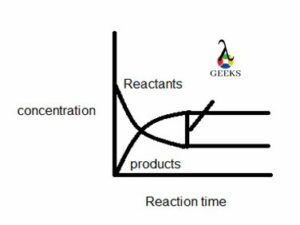Types of reactions in terms of directions and the reversible reaction examples as follows:
Reversible reaction- The reactions which proceed in both forward and reverse direction simultaneously are called reversible reactions. It is represented as ⇋
Reactants ⇋ Products
Explanation of reversible and irreversible reactions and reversible reaction example:
Irreversible reaction:
Here, if we see the graph of irreversible reaction, it is as follows. As the reaction proceeds reactants start being converted into products so the concentration of reactants in that reaction apparatus started decreasing and it kept on decreasing until it was zero all the reactants were used up during the reaction. Similarly in the beginning concentration of products was zero but with the passage of time concentration of products kept on increasing and it reach to its maximum obtainable level.

Reversible reaction
The double arrows are two half arrows in opposite direction. One is facing to the forward direction and other is facing to the reverse direction. That means there are two reactions taking place in this reaction mixture. In one reaction, reactants being converted into products, this is a forward reaction. The bottom arrow represents the reverse reaction. In this reaction products are being converted into reactants. This is a reverse reaction.
As we see the graph for reversible reaction. The reactants in the beginning were in maximum concentrations and products were not there in the beginning because the reaction started with reactants, so the concentration of the products in the beginning as zero. As the reaction proceeded concentration of reactants kept on decreasing because they were being converted into products. Similarly products were being formed so the concentration of products kept on increasing but after some time the line of reactants concentration straightens up it does not goes to zero, similarly the line for the concentration of products also straighten up it does not reaches its maximum possible value, these two line becomes parallel to each other after some time.

Equilibrium or Dynamic equilibrium
The rate of forward reaction has become equal to the rate of reverse reaction. So reactants are being converted into products and products are still being converted into reactants but both these processes are taking place in the same rate that is why the concentration of reactants and products is not changing anymore, now this condition is called equilibrium. These happen in reversible reaction only.
“It is the position when the forward reaction becomes equal to the rate of reverse reaction”.
Position = concentrations of reactants and products.
That means the position/concentration at which the rate of forward reaction is equal to the rate of reverse reaction.
If the position of equilibrium is shifting towards right (product) side, that means the concentration of products is increasing and the concentration of reactants is decreasing. That means forward reaction is dominating over the reverse reaction. So products are being formed at higher rate as compared to the formation of reactants. If the equilibrium position shifting to left, which means the concentration of reactants is increasing and the concentration of products is decreasing because the reverse reaction is not dominating over the forward reaction.
Factors affecting equilibrium position:-
When we are talking about factors affecting equilibrium position means we are talking about reversible reaction. Because in chemical reactions the equilibrium position is attained only in reversible reaction, there is no such concept for irreversible reaction.
Here we have to analyse which factors could affect the position of equilibrium, these are the same factors which actually affect the rate of reactions. So basically we have to analyse all those factors which affect the rate of reaction that do they effect the position of equilibrium or not.
So the factors affect the rate of reaction as follows.
Concentration
“If concentration of reactants is increased, equilibrium position shifts to the forward side and the yield of products increases”.
“If concentration of products is increased, equilibrium position shifts to the reverse side and the yield of products decreases”.
“If concentration of reactants is decreased, equilibrium position shifts towards the reverse side and the yield of products decreases”.
“If concentration of products is decreased, equilibrium position shifts to the forward side and the yield of products increased”.
Temperature
For all reversible reactions of forward reaction is exothermic. There reverse reaction is endothermic. But if the forward reaction is endothermic then the reverse reaction is exothermic.
Increase in temperature favors the endothermic side of the reaction and decrease in temperature favors the exothermic side of the reaction.
Pressure
Increase in pressure favors the side with less gaseous moles and decrease in pressure favors the side with more gaseous moles. Here are some reversible reaction examples showing effect of pressure.
Example: 1) 2SO2 (g) + O2 (g ⇋ 2SO3 (g)
Reactant side product side
We have to consider gases only during pressure applying no liquid or solid. Here during analysis the molar ratios of the variables should be consider as number of moles. So in above reaction, on the reactant side there are two moles of sulphur dioxide and two moles of oxygen, so there are 2 + 1 = 3 gaseous moles. In product moles there is only one product and it has two moles of sulphur trioxide present in the product side. So the product side has less gaseous moles as compared to reactant side. So we have more and more products to be formed, but we have to keep a high pressure.
In the above reaction, a high pressure will increase the yield of product because there are less gaseous moles on the product side and increase in pressure favours the side with less gaseous moles.
Example 2) N2 (g) + 3H2 (g) ⇋ 3NH2 (g)
In the above example, there are 1 + 3 = 4 gaseous moles on the reactant side and there are total 2 gaseous moles on the product side. So we want to increase the yield of the product so we want these side to be favoured which has less gaseous moles. So a high pressure will increase the yield of the product.
Example 3) H2 (g) + I2 (g) ⇋ 2HI (g)
On the reactant side of example 3), there are 1 + 1 = 2 gaseous moles on the reactant side and two gaseous moles on the product side, so technically none of the side has a higher or lower number of gaseous moles. The number of gaseous moles on each side is exactly equal, that means the equilibrium position will not be affected by pressure.
Example 4) Ca (s) + 2CH2COOH (aq) ⇋ (CH3COO)2Ca (aq) + H2 (g)
In the 4) example on reactant side there is a solid and an aqueous reactants, there is no gas on the reactant side. Here we do not have to evaluate only number of moles; we have to evaluate only number of gaseous moles. There are zero gaseous moles on reactant side, but there is one gaseous product on the product side and if we want to increase the yield of the products, we need to keep the pressure low, because low pressure favours the side with the greater number of gaseous moles.
- Presence of a catalyst
Rates of reactions increases in presence of a catalyst, catalyst is a substance which increases the rate of a reaction without itself being chemically changed. A catalyst does increase the rate of reaction but it increases the rate of both forward and reverse reaction equally. So the overall effect is cancel out, that means it does not favors any side, the presence or absence of a catalyst has no effect on equilibrium position or the yield of the products.
Some more reversible reaction examples:
Example 5) Bronsted-Lowry concept of acid and bases
Acid= Substance (molecule or ion) which donates proton (H+ ions)
HCl + H2O ⇋ H3O+ + Cl-
Base= Substance (molecule or ion) which accepts proton (H+ ions)
NH3 + H2O ⇋ NH4+ + OH–
Read more on 10+ Acid-Base Reaction Example: Detailed Explanations
Example 6) Conjugate acid base pair
In an acid-base reaction pair of substance which differs by a proton and which can be formed from one another by the gain or loss by proton are called as conjugate acid-base pair.
HCN + H2O ⇋ H3O+ + CN–
Example 7) Hydrolysis reaction
Salt of strong acid and weak base
NH4Cl + H2O ⇋ HCl + NH4OH
Salt of weak acid and strong base
CH3COONa +H2O ⇋ CH3COOH + NaOH
Salt of weak acid and weak base
(NH4)2CO3 +2H2O ⇋ H2CO3 + 2NH4OH
Example 8) Common ion effect
The phenomenon in which degree of dissociation of weak electrolytes supressed by adding small amount of strong electrolyte containing a common ion is called common ion effect.
CH3COOH(aq) ⇋ CH3COO–(aq) + H+(aq)
Example 9) Buffer solutions
Acidic buffer
CH3COONa ⇋ CH3COO– + Na+
Basic buffer
NH4OH ⇋ NH4+ + OH–

Hello everyone, I am Dr. Shruti M Ramteke, I did my Ph.D. in chemistry. I am passionate about writing and like to share my knowledge with others . Feel free to contact me on linkedin